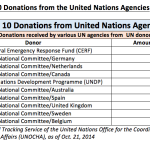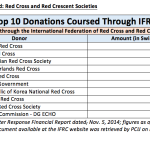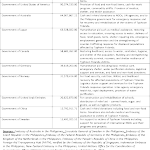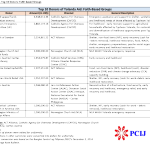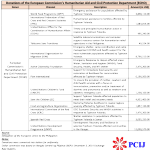EXACTLY THREE months after Yolanda struck central Philippines, the government launched a worldwide campaign to thank everyone who had rushed to the country’s aid in the supertyphoon’s aftermath. Aside from print and TV ads, the government also paid for billboards in nine famous cities across the globe – New York, London, Paris, Berlin, Toronto, Tokyo, Seoul, Singapore, and Sydney — expressing the Filipinos’ gratitude for the hand extended to them by people all over the world. Indeed, while Filipinos themselves rushed to help their countrymen in need, the global response to the tragedy was overwhelming.
“The world has been one with the Philippines in helping rebuild the nation,” the Philippine tourism department said in a statement. Its official “thank you” video also said: “You’re making all the difference.”
Among those receiving these thanks were the major Yolanda aid donors, including:
THE UNITED NATIONS FAMILY
The United Nations coordinates international humanitarian assistance through an Inter-Agency Standing Committee or IASC. IASC includes key UN and non-UN humanitarian partners that take charge of coordination, policy development, and decision-making at the global level. It is composed of:
- Food and Agriculture Organization of the United Nations (FAO);
- United Nations Development Programme (UNDP);
- United Nations Population Fund (UNFPA);
- United Nations Human Settlements Programme (UN-HABITAT);
- The Office of the United Nations High Commissioner for Refugees (UNHCR);
- United Nations Children’s Fund (UNICEF);
- World Food Program (WFP);
- World Health Organization (WHO); and
- Office for the Coordination of Humanitarian Affairs (OCHA).
IASC also has standing invitation to the International Committee of the Red Cross (ICRC), the International Federation of Red Cross and Red Crescent Societies (IFRC), and the International Organization for Migration (IOM), among others.
The IASC’s head is an Emergency Relief Coordinator whose duty includes appointing a Humanitarian Coordinator (HC) to oversee the interventions in case of complex emergencies in a country. After an HC is designated, a Humanitarian Country Team (HCT) is formed to organize the operations of UN agencies and other international organizations responding to the disaster at the country level.
Starting the day after Yolanda struck, international humanitarian groups carried out separately and for the HCT, in clusters, an initial survey of the conditions of the affected region. This “needs assessment” survey became the basis of the HCT’s strategic response plan and other separate projects of the organizations.
Consolidated appeals to donor countries and other agencies for funding are launched using these plans. Donors respond with pledges and commitments to support the projects. With these donations, the channel implements the project by itself or through a partner, which may either be another international nongovernment organization (INGO), a local NGO or a local government unit or LGU.
Donations received by these organizations are recorded in OCHA’s Financial Tracking System (FTS). The system maintains a list of all donations voluntarily reported to the OCHA by donors and organizations. The list contains donor names, channels, and amounts pledged and contributed to the organization. There is no further information on how the funds are allocated per project, as well as its implementation and beneficiaries.
The UN and its agencies, however, do not only act as channels or conduits for donations. They also manage funds from UN members that may be used to respond to immediate needs, as in the case of disasters.
UN General Assembly Resolution No. 46/182, which outlines the framework for the IASC, also provides for the creation of key funding programs under the organization. These include the Joint Strategic Planning and Appeals Process (described above) and the Central Emergency Response Fund or CERF.
The CERF is a pool of funds from annual contributions of governments, private sector foundations and individuals, reserved specifically for humanitarian assistance. It supports rapid response to emergencies and covers other critical areas not yet funded by donors.

Data from OCHA’s Financial Tracking System as of Oct. 21, 2014, show that the UN used US$25.28 million of CERF, as well as unearmarked funds from FAO, ILO, and UNDP to support its Yolanda-related operations.
The funds were coursed through other UN agencies and used to support projects and programs under the Strategic Response Plan (SRP). This support from UN agencies, in addition to the funds gathered by UNICEF, make up 17 percent of the funding for the SRP, which had a total funding of US$468 million as of last Oct. 21.

The national committees of UNICEF in various countries, meanwhile, registered the highest amount of funds coming from a UN agency.
After the appeal for the SRP was launched, UNICEF also launched its own appeal for funding to the UNICEF national committees. These bodies likewise had their own campaigns for funding, which were later downloaded to UNICEF Philippines to support its Yolanda-related operations.
THE GOVERNMENTS OF THE WORLD
Scores of foreign governments extended donations in cash and in kind to agencies of the United Nations, international NGOs, and the Philippine government for emergency response and recovery efforts in the typhoon-affected areas.
The donations by foreign governments, however, were not all captured to the last centavo in the records of the Financial Tracking Service (FTS) of the United Nations Office for the Coordination of Humanitarian Affairs or OCHA.
PCIJ attempted to collect pertinent data from the embassies of donor countries and from the UN OCHA.
OCHA’s FTS was used to identify which foreign governments donated to Yolanda victims.
PCIJ then sent request for information to the 58 foreign governments that were identified in OCHA’s FTS but only nine responded with documents. The other embassies said that they did not have the requested information or that these were not available in their files. A few others promised to provide PCIJ with the data, once these become available.
In the end, PCIJ data on the donations of foreign governments to Yolanda victims came from 10 sources, including OCHA.
The nine countries that gave PCIJ the requested information are Australia, China, the Czech Republic, Germany, Indonesia, the Netherlands, New Zealand, Singapore, and Sweden.
Some of the donations they reported were not listed in OCHA’s FTS. Hence the amount of donations reported to PCIJ is much higher than what appeared in OCHA’s FTS.
PCIJ also requested from these donor governments the complete list of their aid, which projects or activities these supported, and which organizations served as channels or conduits of their donations.
PCIJ then consolidated the data from the embassies with the data from OCHA’s FTS. Because the donations were quoted in different currencies, PCIJ converted the amounts into dollars using the December 3, 2014 exchange rate bulletin of the Bangko Sentral ng Pilipinas (BSP) as reference.
In all, the data show that 58 foreign governments donated a combined total of US$618,315,107.26. By category, the amount consisted of cash donations of US$546,147,641.52 and non-cash donations of US$72,167,465.74.
Of the 58 countries, the government of the United Kingdom gave the biggest donation: US$121,153,336.00. The U.S. government came in second with a total of US$90,074,530. The bulk of the U.S. government donation was channeled through international NGOs and UN agencies.
The Australian government gave the third biggest donation amounting to US$64,907,867.22. Coming in fourth was the Japanese government with US$63,328,022, while fifth was the Canadian government with US$58,682,262.00.
The German government had the sixth spot. Although OCHA’s FTS shows the the German government as having donated just more than US$16 million, the German embassy informed PCIJ that the German government had in all donated EUR32 million or the equivalent of US$39.6 million.
Similarly, the government of the People’s Republic of China, which international media reports said donated only US$100,000 for disaster relief, said it had extended multiple times more aid for Yolanda’s victims.
According to the report sent by the PROC embassy to PCIJ, China’s total donations actually came to US$15,792,911.71. It also said that the donations (cash and non-cash) had been channeled through several Philippine government agencies such as the Department of Social Welfare and Development, Department of Health, Department of Foreign Affairs, National Food Authority, and National Housing Authority.

The bulk of the donations from foreign governments, or US$74,809,468, was coursed through the UN’s World Food Programme.
The Philippine government also served as channel for donations amounting to more than US$60 million. The other channels that received significant amounts of donations are FAO, UNICEF, and IFRC.
Some of the international organizations that received funds from foreign governments have local implementing partners, too. Often, these implementing partners are local chapters of international organizations such as Caritas, Red Cross, and World Vision.
The other implementing partners included local NGOs such as Gawad Kalinga, local foundations such as ABS-CBN’s Sagip Kapamilya and Talarak Foundation, and government agencies such as the Departments of Education, Foreign Affairs, Health, and Social Welfare and Development, as well as the National Food Authority and National Housing Authority.
THE INTERNATIONAL FEDERATION OF RED CROSS AND RED CRESCENT SOCIETIES
On Nov. 12, 2013, four days after Typhoon Yolanda made landfall on the Philippines, the International Federation of Red Cross and Red Crescent Societies launched an emergency appeal for its humanitarian operations.
The appeal sought assistance from various Red Cross and Red Crescent societies, governments, foundations, and corporate donors to fund its plan of action for disaster relief and recovery for Yolanda. The plan, which was expected to run until December 2016, had an overall revised budget of CHF99.88 million.
As of Jan. 5, 2015, one Swiss franc (CHF) is equivalent to PhP44.74.
Data from IFRC show that as of Sept. 30, 2014, the Federation had gathered 78.88 million Swiss francs for its plan. The amount is made up of 70.23 million Swiss francs in cash contributions, 7.41 million Swiss francs in kind, and CHF1.24 million classified as other income. (See Donor Table).

THE INTERNATIONAL RED CROSS AND RED CRESCENT MOVEMENT
The IFRC is but a part of the broader International Red Cross and Red Crescent Movement.
The Movement is a global humanitarian network of organizations. It has three main components: the IFRC, the International Committee of the Red Cross, and the 189 national societies, which include the Philippine Red Cross (PRC).
The ICRC is responsible for coordinating the network’s relief operations in conflict and war situations. The IFRC, meanwhile, directs assistance to victims of natural and man-made disasters. The different national societies provide a wide array of services ranging from disaster response to first-aid training, to restoring family links.
These organizations are independent from one another. Each has its own status and has no authority over the others. Nonetheless, they convene in an international conference every four years and in a general assembly every two years to discuss priorities, challenges, and policies, among others.
For the network’s typhoon Yolanda operations, the lead role was assigned to the PRC. The ICRC provided support to the PRC in conflict and typhoon-related areas (Samar) while IFRC assumed the role in non-conflict disaster areas (Leyte and Panay). The bodies agreed on the tasks days after the typhoon to ensure the movement’s coordinated response.
In all, the Red Cross and Red Crescent Movement raised a total of CHF345.6 million for Yolanda, of which CHF104.4 million has already been spent as of this writing. The figures include financial data from the IFRC, ICRC, and 27 national societies including the PRC as of August 2014, based on the network’s one-year progress report.

A total of 136 national societies participated in the Red Cross and Red Crescent intervention, including 15 in-country societies. These independent organizations worked either multilaterally (by responding to the IFRC appeal), bilaterally (through partnerships with the PRC), or even unilaterally.
A real-time evaluation of the network’s Yolanda response noted that some national societies chose not to fully engage with the standard IFRC multilateral approach in order to more tangibly and visibly contribute to the response. But contributions made directly to the PRC, bypassing the IFRC system, “often resulted in unsolicited goods and services sometimes below IFRC standards,” said the report.
Commissioned by the IFRC, the study was conducted from February to March 2014.
FAITH-BASED NONGOVERNMENT ORGANIZATIONS
Many international NGOs worked with those based in the Philippines to provide emergency aid and help in the recovery and rehabilitation of typhoon-affected areas.
PCIJ sent request letters for information to more than 50 international NGOs listed in OCHA’s FTS. Several responded but only four provided PCIJ with complete information: ACT Alliance, Caritas Austria, Norwegian Church Aid (NCA), and Catholic Agency for Overseas Development (CAFOD).
The donations culled from the reports of these four NGOs were in different currencies. PCIJ thus converted the donations in different currencies into U.S. dollars using the December 3, 2014 exchange rate bulletin of the Bangko Sentral ng Pilipinas (BSP) as reference.
Altogether, the four faith-based NGOs reported raising total donations of US$23,472,025.85. All four are humanitarian organizations of church groups.
More than half of the total donations were coursed through ACT Alliance. A coalition of 150 churches and affiliated organizations, it got approximately US$13.5 million. Majority of its donors are alliance members. Its programs and projects in the Yolanda-affected areas are still ongoing.
The other implementing partners of ACT Alliance included the Lutheran World Relief, the Philippine-based National Council of Churches in the Philippines (NCCP), and Christian Aid (CA). The biggest donor of ACT Alliance, ICCO & Kerk in Actie, The Netherlands is an implementing partner of ACT Alliance.
For its part, the NCA, also an implementing partner of ACT Alliance, informed PCIJ that it received donations from the Norwegian Ministry of Foreign Affairs.
CAFOD, meanwhile, received US$8,115,305.76 from individual donors and Disasters Emergency Committee, a fund-raising organization of 13 leading aid charities in the United Kingdom. CAFOD is the official Roman Catholic aid agency for England and Wales. It is part of Caritas International, and has local implementing partners such as CBCP-NASSA (Caritas Philippines) and Philippines Social Enterprise Network.
Caritas Austria, Caritas Italy, Caritas Luxembourg, and Diakonie Germany donated a total of US$3,457,181.30. These foreign NGOs have local implementing partners such as the Jaro Archdiocesan Action Center (JASAC), Diocesan Social Action Center (DSAC), Citizens Disaster Response Center (CDRC), andNational Secretariat for Social Action (NASSA) – Caritas Philippines.

THE EUROPEAN COMMISSION’S HUMANITARIAN AID AND CIVIL PROTECTION DEPARTMENT (ECHO)
OCHA’s FTS includes the European Union in its list of donors for Yolanda survivors. PCIJ thus sent a request for information to the Delegation of the European Union to the Philippines. It responded by providing PCIJ with the list of Typhoon Yolanda projects under the European Commission’s Humanitarian Aid and Civil Protection Department (ECHO), which was created in 1992 to help victims of conflict and disasters.
The total cost of the 13 projects supported by ECHO reached US$49,152,570. The Delegation said its implementing partners included the World Food Programme, IFRC, OCHA, Télécoms Sans Frontières, International Organization for Migration, Active Citizenship Foundation, Plan International, UNICEF, Save the Children, FAO, ICRC, Spanish Red Cross, and UNDP.

Most of the ECHO-supported projects involved emergency assistance. The rest are livelihood restoration projects. The biggest one funded by ECHO is UNDP’s Recovery and Resilience project, at a cost of US$12,009,570. It is also the longest running project under ECHO, ending in 2017 yet. Six of the 13 projects supported by ECHO have been completed, while the rest are still ongoing.
– With additional research and reporting by Rowena F. Caronan, Cong B. Corrales, Ojie Sarmiento, Che de los Reyes, Earl G. Parreño, and Malou Mangahas, PCIJ, January 2015
DATA TABLES:
Acknowledgment:
“Christian Aid funded this project/report as our contribution to the interest of the public’s right to know how the Yolanda funds are managed and used, and that the findings and recommendations are meant to feed into the policy discourse on Republic Act No. 10121 (The Philippine Risk Reduction and Management Plan of 2010) review and the Yolanda budget process.”



